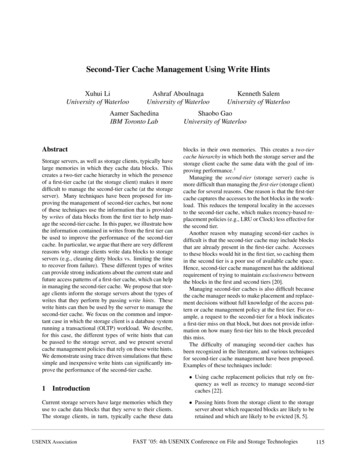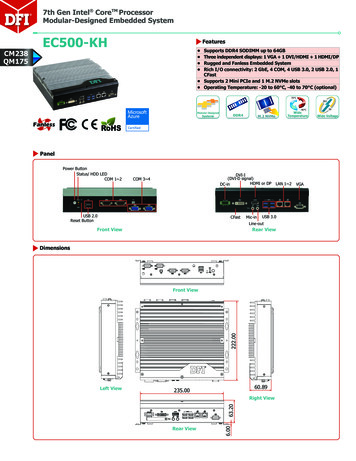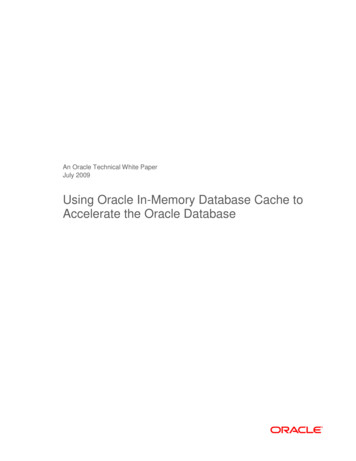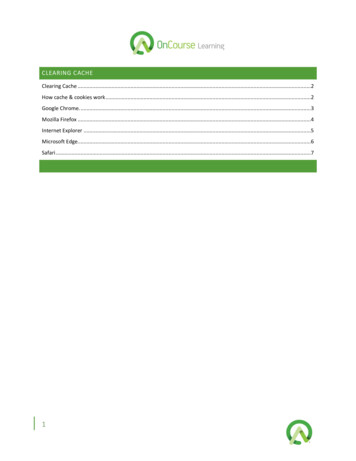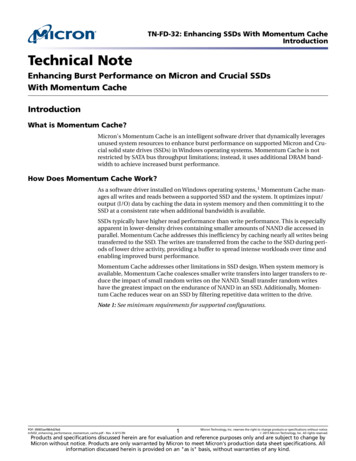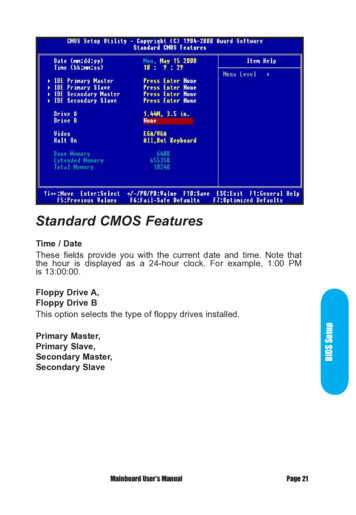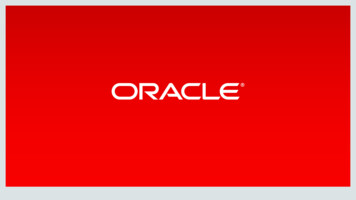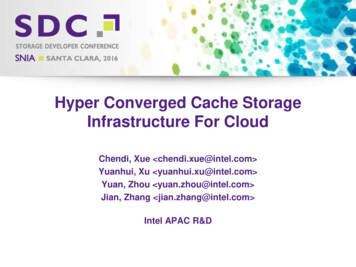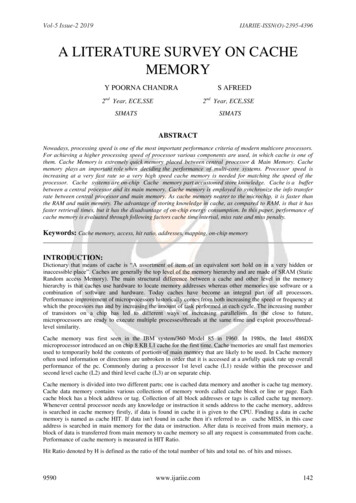
Transcription
Vol-5 Issue-2 2019IJARIIE-ISSN(O)-2395-4396A LITERATURE SURVEY ON CACHEMEMORYY POORNA CHANDRAS AFREED2nd Year, ECE,SSE2nd Year, ECE,SSESIMATSSIMATSABSTRACTNowadays, processing speed is one of the most important performance criteria of modern multicore processors.For achieving a higher processing speed of processor various components are used, in which cache is one ofthem. Cache Memory is extremely quick memory placed between central processor & Main Memory. Cachememory plays an important role when deciding the performance of multi-core systems. Processor speed isincreasing at a very fast rate so a very high speed cache memory is needed for matching the speed of theprocessor. Cache systems are on-chip Cache memory part accustomed store knowledge. Cache is a bufferbetween a central processor and its main memory. Cache memory is employed to synchronize the info transferrate between central processor and main memory. As cache memory nearer to the microchip, it is faster thanthe RAM and main memory. The advantage of storing knowledge in cache, as compared to RAM, is that it hasfaster retrieval times, but it has the disadvantage of on-chip energy consumption. In this paper, performance ofcache memory is evaluated through following factors cache time interval, miss rate and miss penalty.Keywords: Cache memory, access, hit ratio, addresses, mapping, on-chip memoryINTRODUCTION:Dictionary that means of cache is “A assortment of item of an equivalent sort hold on in a very hidden orinaccessible place”. Caches are generally the top level of the memory hierarchy and are made of SRAM (StaticRandom access Memory). The main structural difference between a cache and other level in the memoryhierarchy is that caches use hardware to locate memory addresses whereas other memories use software or acombination of software and hardware. Today caches have become an integral part of all processors.Performance improvement of microprocessors historically comes from both increasing the speed or frequency atwhich the processors run and by increasing the amount of task performed in each cycle. The increasing numberof transistors on a chip has led to different ways of increasing parallelism. In the close to future,microprocessors are ready to execute multiple processes/threads at the same time and exploit process/threadlevel similarity.Cache memory was first seen in the IBM system/360 Model 85 in 1960. In 1980s, the Intel 486DXmicroprocessor introduced an on chip 8 KB L1 cache for the first time. Cache memories are small fast memoriesused to temporarily hold the contents of portions of main memory that are likely to be used. In Cache memoryoften used information or directions are unbroken in order that it is accessed at a awfully quick rate up overallperformance of the pc. Commonly during a processor 1st level cache (L1) reside within the processor andsecond level cache (L2) and third level cache (L3) ar on separate chip.Cache memory is divided into two different parts; one is cached data memory and another is cache tag memory.Cache data memory contains various collections of memory words called cache block or line or page. Eachcache block has a block address or tag. Collection of all block addresses or tags is called cache tag memory.Whenever central processor needs any knowledge or instruction it sends address to the cache memory, addressis searched in cache memory firstly, if data is found in cache it is given to the CPU. Finding a data in cachememory is named as cache HIT. If data isn't found in cache then it's referred to as cache MISS, in this caseaddress is searched in main memory for the data or instruction. After data is received from main memory, ablock of data is transferred from main memory to cache memory so all any request is consummated from cache.Performance of cache memory is measured in HIT Ratio.Hit Ratio denoted by H is defined as the ratio of the total number of hits and total no. of hits and misses.9590www.ijariie.com142
Vol-5 Issue-2 2019IJARIIE-ISSN(O)-2395-4396Hit ratio Total number of hits/(Total no.of hits Total no.of misses)Miss Ratio is denoted by M is defined asM 1 – Hit ratioFor measuring the performance of multi core processor we use Instruction per Cycle (IPC) and Cycle PerInstruction (CPI). IPC is number of instructions are executed in one cycle. IPC 1/(Number of Instruction )CPI is number of cycles are needed to execute one instruction.Fig 1:-Block diagram of cache memoryCache memory is based on principal of section of References.By this we tend to mean once a program executes on a pc, connected storage locations being often accessed.Temporal section refers to the utilize of specific data and/or resources among comparatively little timedurations. Spatial locality refers to the employment of data parts among comparatively shut storage locations.The transformation of data from main memory to cache memory is referred as a mapping method. Basically,there are three methods for mapping addresses to cache locations - direct mapping, associative mapping and setassociative mapping. Direct mapping is the simplest technique which maps each block of main memory intoonly one possible cache line. In associative mapping each block of main memory maps into any line of thecache. In set associative mapping cache is divided into sets, each of which consists of cache lines or blocks andeach block of main memory maps into any of lines of set.Fig 2:- Cache mappingSeveral of the cache design parameters will have a significant effect on system performance. The choice of linesize is important. Selecting the degree of set associativity is another necessary trade-off in cache design.However, increasing the degree of set associativity will increase the value and quality of a cache, since thenumber of address comparators needed is equal to the degree of set associativity. Recent cache memory analysishas created the fascinating result that an on the spot mapped cache can typically outperform a group associative(or totally associative) cache of identical size even though the direct mapped cache will have a higher miss ratio.This is because the increased complexity of set associative caches significantly increases the access time for acache hit. As cache sizes become larger, a reduced access time for hits becomes more important than the smallreduction in miss ratio that is achieved through associativity.LITERATURE REVIEW ON CACHE MEMORY:Our Review is based on various cache memories and performance issues in multicore processors.To obtain greater parallelism the cache can be loaded in a bit slice mode so that it contains a slice of two ormore bits from each word instead of single bit from each word. Majority of memory requests are executed in9590www.ijariie.com143
Vol-5 Issue-2 2019IJARIIE-ISSN(O)-2395-4396cache. Microelectronics memories can be embedded effectively as cache memories. Instructs the computersystem how to load the cache. The systems can make effective use of cache without any explicit guidance fromprograms. Cache memory has limited capacity. Not suitable for high performances computer and Cached data isstored only so long as power is provided to cache [1]. Cache memory serves the buffering function of reducingtraffic between processor and main memory very substantially. Problems of multiple copies of data must beresolved by using cache memory. It’s either read or a write miss - some limited data suggests that this results inslightly better performance and it reduce memory contention. Reuse and locality of programs in computer.Cache memory is not flexible. In a direct mapped cache, possible to assume a hit and continue. Recover later ofmiss. Miss ratio is high in cache memory [2]. Analytical determination of the optimum capacity of a cachememory with given access time and of its matching storage hierarchy has been achieved based on an earliermodel of linear storage hierarchies. The resultant formulas show explicit functional dependence of the cache'scapacity, and the capacities and the access times of other storage levels, upon the miss ratio parameters andtechnology cost parameters as well as the required hierarchy capacity and the total allowable cost. In particular,the cache size is directly proportional to the hierarchy cost, and larger cache access time or larger miss ratiorequires a larger cache for optimum performance. Cache memory requires an inter process call for each cacheaccess and Difficult to implement. Use larger cache size with additional block frames to avoid contention [3].Cache memory gives a good indication of relative performances and it predicts page fault rates reasonably well.It is analytically tractable. Replacement algorithms of block when new block read into cache (Associativesearch). No page replacement policy. Cache hit performance is poor and Consuming different amounts ofpower in their on and off states and Access time is high [4]. The very fast Josephson NDRO cache memorydesign are structured and are interfaced with one another. The discussion has centered on the performance of aIK-bit array, four of which we expect ultimately to place onto a 6.35- x 6.35mm chip. Extremely fast switching( 10ps). Extremely low power dissipation (500 nW per circuit). Operation at very low temperatures ( 4k).Josephson devices are attractive for ultrahigh-performance computers. Conducting strip lines and ground planeswith zero electrical resistance. Bus traffic memory is high and Memory bandwidth is high. Complex circuitryrequired to examine tags of all caches line in parallel [5].The use of cache memory, however, has often aggravated the bandwidth problem rather than reduce it.Reducing processor memory bandwidth. On chip memory perform as fast as the more powerful processor andMaximizing the hit ratio. Its Minimizing the access time to data in the cache. Minimizing the overheads ofupdating main memory, maintaining multi-cache consistency [6]. For single-chip computers to achieve highperformance, on-chip memory must be allocated carefully. Pin bandwidth is limited. It consistently works well.It takes dynamic program behaviour into account. It outperforms a data cache by nearly a factor of two in bothspeed and cost. It potentially can use better algorithms with information available at compile time to preloaddata into registers and purge data more effectively than a data cache. Registers should perhaps be thought of aslocal memory. Requires large number of memory cycles. The register should be updated in every cache area.Time requirement is high for transferring the data between memory and cache [7]. A cache memory reduces themain memory traffic for each processor. Require less time to transmit between main memory and cache. Requirefewer memory cycles to access if the main memory breadth is slim. Require fewer address tag bits in the cache.Minimize bus cycle time and Increase bus width to Improve bus protocol. Frequency based replacementschemes. Cache memory size is high. Cache memories are most likely to impact system performance [8].Reducing Conflict Misses: Miss Caching and Victim Caching. Combining Long Lines and Stream Buffers.Stream buffers that may prefetch down many streams at the same time. Reduce cache miss rates and improvesystem performance. Effective increase in data cache size provided with stream buffers and victim caches using16B lines. Can effect overall system performance and Practical only for small caches. Size of data cache is high[9]. Increasing Write-Back Cache Bandwidth. Reducing Write-Through Cache Traffic. Limiting codeexploitation these directions to the machines with cache line sizes capable or smaller than that assumed withinthe allot directions. Extra execution overhead for the cache allocation directions. Cache Memory affects theexecution time of a program and high hardware complexity. It requires more cycles are required [10].High hardware complexity. It is not used in hard real-time systems. No conflict when accessing instruction.Scalability issues [11]. Cache memory being the common technique to bridge the speed gap. Excess CPI withcache. Replacement policy (random, LRU, FIFO) Write policy (CBWA, WT).Full associative (Area PLA Data Tag.). Memory must be updated with each cache. Could run into issues syncing caches. It cannot storesthe previous state. Pre- fetch is not done [12].It can be used in hard real-time systems. Reducing the upper limitexecution time. It is restored to its previous state when the preempted task is reloaded. Worst casespecifications, frequently resulting in under-utilization of the processor. Extremely large caches (up to 511GB).Affecting the architecture of the next level of the memory hierarchy and performance is low in real timesystems. Worst case execution time is high [13].Selective victim caching, for improving the miss-rate of directmapped caches. It does not affect the cache access time. Places data in the main cache. Improvement in missratio. Improving number of interchanges between the main direct-mapped cache and the victim cache over9590www.ijariie.com144
Vol-5 Issue-2 2019IJARIIE-ISSN(O)-2395-4396simple victim caching. High access time. No algorithm when applied to data caches. Requires more randompatterns of data references [14]. Cache memories are small fast memories used to temporarily hold the contentsof memory. Caches became an integral a part of all processors. Virtually addressed caches do not requireaddress translation during cache access .Multiple-access cache, Decoupled cache. More and more silicon area isbeing dedicated to the on-chip caches .Processor become increasingly superscalar. Requires more aggressivedesigns to handle multiple requests per cycle [15].Decide what to try and do – execute directions to calculate new positions etc. Actuate – control the process bygiving a signal to a controlling device (motor, relay etc.)Inline probes are placed directly in the application code.Bottleneck problem for an embedded system. High peak power and memory is unable to keep pace with theCPU [16]. Executing multiple processes at the same time like in CMP/SMT systems. Reducing cacheinterference. Dynamically partitions the cache amongst the processes. Processor with multiple functional units.While executing processes require large caches. A small number of additional counters are required. Cannotimprove the performance if caches are too small for the workloads [17].3D graphics cache system to increasememory utilization. Solving a memory bottleneck problem for an embedded system. Decrease an intensivememory access during a short period and maximize memory utilization. Reduce power consumption bysupporting an AXI low power interface. Improving on-chip bus. Implementation is difficult [18]. High speedmulticore processor. To improve the timing. By aligning cell instances into "vectors", we reduce control andclock loading. Largest Benefit Quick feedback to the DE for Area & Timing. Quick to proto-type different datapath configuration. Replacement circuit becomes more complicate. High complexity. Design of cache memoryis complicated [19]. Design of cache memory on FPGA for police investigation cache miss. Higher performancewith lower power.Fig-3:- Cache sizeCache controller for chase the induced miss rate in cache memory. On-chip energy consumption. Noreplacement policies. Time execution is high [20].Faster replacement ways generally keep track of less usage info. To reduce the amount of time needed to updatethat info. In the case of direct-mapped cache, no information. Video and audio streaming applications. Cacheinformation that will be used again (cache pollution). Number of transistors on chip increasing on the far sideone billion. World scientific codes already exceed the maximum capacity. Scientific computing typically requireseveral Megabytes up to hundreds of Gigabytes of memory [21]. The rate of conflict misses is reduced byexploitation larger block size, larger cache and way prediction methods. However, exploitation larger block sizecould increase miss penalty, reduced hit time and power consumption. On the opposite aspect, larger cacheproduces slow access time and high cost. It is associated with cache coherence problem. Higher associativityturn out quick interval however they need low cycle time. Problem Matrix multiplication of different size. Hardto identify a certain cache optimization technique. Larger cache produces slow access time and high cost [22].Higher associatively turn out quick interval however they need low cycle time. Victim cache reduces miss rateat a high cost comparing to Cache miss look aside. In all we will say that there's a space for up performance ofcache memory to a really giant extent. Cache Memory affects the execution time of a program [23]. Flashmemory provides high performance, high capacity, and stable quality of service (QOS). Increases the amount ofdata processed by the processor. Cache size increased from 2KB to 16KB and performance increase was273.8% for random write, 214.4% for random read. Traffic increases between processor and cache memory.More cache misses. Cache misses cause cache miss penalty to degrade overall storage performance [24]. Theperformance of cache on the basis of replacement policies such as LRU, FIFO and Random. They found that theLRU policy in the data cache has better performance than FIFO and Random. The instruction cache replacementpolicies. They proposed a new loop model. In its loop model, they found that random replacement hasperformed better than LRU and FIFO. However, each simulation has different cache sizes, different cache9590www.ijariie.com145
Vol-5 Issue-2 2019IJARIIE-ISSN(O)-2395-4396associativity and different benchmarks. Therefore, the performance comparisons of policies are less accurate. Aunified simulation should be implemented for all policies to compare their performance [25].Fig 4:- Traffic reductionCONCLUSION:With all the references of this papers, we discussed cache memory and how to improve the performance ofcache memory. So we can say that Cache memory may be a high-speed random access memory that isemployed by a system Central process unit for storing the data/instruction temporarily. It decreases theexecution time by storing the foremost frequent and most probable data and instructions "closer" to theprocessor, wherever the systems central processing unit will quickly catch on. Future caches are larger andsmarter, the data structures presently used in real. Today's applications in scientific computing usually needmany Megabytes up to many Gigabytes of 90H. A. Curtis, "Systematic procedures for realizing synchronous sequential machines using flip-flopmemory: Part I," IEEE Trans Computers, vol. C-18, pp. 1121-1127, December 1969.R. 0. Winder, "A Data Base for Computer Performance Evaluation", presented at IEEE Workshop onSystem Performance Evaluation, Argonne, Ill., October 1971, and published in COMPUTER, vol. 6,no. 3, March 1973.C. Chow, "An optimization of memory hierarchies by geometi programming," in Proc. 7th Annu. Sa.Syst., 1973, p. 15.AVEN, O I, ET AL Some results on distribution-free analysis of pagmg algorithms IEEE TransComptrs C-25, 7 (July 1976), 737-745.P. Gueret, A. Moser, and P. Wolf, IBM J. Res Develop. 24 (1980, this issue).[Amdahl 82] C. Amdahl, private commuvtict tiovt, March 82.Hasegawa, M. and Y. Shigei, "High-Speed Top-Of-Stack Scheme for VLSI Processors: a ManagementAlgorithm and Its Analysis," Proceeding of the 12th Annual International Sym- posium on ComputerArchitecture, June, 1985.DONALD C. WINSOR AND TREVOR N. MUDGE. “Analysis of Bus Hierarchies forMultiprocessors”. The 15th Annual International Symposium on Computer Architecture ConferenceProceedings, Honolulu, Hawaii, IEEE Computer Society Press, May 30–June 2, 1988, pages 100–107.Baer, Jean-Loup, and Wang, Wenn-Hann. On the Inclusion Properties for Multi-Level CacheHierarchies. In The 15th Annual Symposium on Computer Architecture, pages 73-80. IEEE ComputerSociety Press, June, 1988.Smith, Alan J. Second Bibliography on Cache Memories. Computer Architecture News 19(4):154182, June, 1991.H. B. Bakoglu, G. F. Grohoski, and R. K. Montoye, “The IBM RISC system16000 processor:Hardware overview,” IBM J. Res. Develop., vol. 34, no. 1, pp. 12-22, Jan. 19.M.J.Flynn, "Computer Architecture: Concurrent and Parallel ProcessorDesign", Jones and Bartlett, Boston, 1994.Lebeck, A.R. and Wood, D.A. (1994). Cache Profiling and the SPEC Benchmarks: A Case Study.IEEE Computer 27(10), 15-26.www.ijariie.com146
Vol-5 Issue-2 2019IJARIIE-ISSN(O)-2395-439614. D. Stiliadis and A. Varma, “Selective Victim Caching: A Method to Improve the Performance ofDirect-Mapped Caches,” Tech. Rep. UCSC-CRL-93-41, U.C. Santa Cruz, cations.html).15. J. Peir, Y. Lee, W. Hsu, \Capturing Dynamic Memory Reference Behavior with Adaptive CacheTopology," 8th ASPLOS, Oct. 1998, pp. 240{250.16. Filip Sebek and Jan Gustafsson. Determining the worst-case instruction cache miss-ratio (paper c). InProceedings of ESCODES 2002, San José, CA, USA, September 2002.17. S. Yang, M. D. Powell, B. Falsafi, and T. N. Vijaykumar. Exploiting choice in resizable cache designto optimize deep-submicron processor energy-delay. In The 8th High-Performance ComputerArchitecture, 2002.18. Kil-Whan Lee, Woo-Chan Park, Il-San Kim, and Tack-Don Han, "A Pixel Cache Architecture withSelective Placement Scheme based on Z-test Result," Microprocessors and Microsystems, Vol. 29,Issue. 1, pp. 41-46, Feb. 2005.19. O. Temam, "An Algorithm for Optimally Exploiting Spatial and Temporal Locality in Upper MemoryLevels," IEEE Trans. Computers, 48, No. 2, pp150-158.20. Nawaf Almoosa, Yorai Wardi, and Sudhakar Yalamanchili, Controller Design for Tracking InducedMiss-Rates in Cache Memories, 2010 8th IEEE International Conference on Control and AutomationXiamen, China, June 9-11, 2010.21. N. Ahmed, N. Mateev, and K. Pingali. Tiling Imperfectly{Nested Loop Nests. In Proc. of theACM/IEEE Supercomputing Conference, Dallas, Texas, USA, 2000.22. Y. Xu, Y. Li, T. Lin, Z. Wang, W. Niu, H. Tang, and S. Ci, “A novel cache size optimization schemebased on manifold learning in Content Centric Networking,” J. Netw. Comput. Appl., vol. 37, pp. 273–281, Jan. 2014.23. M. Kampe, P. Stenstrom, and M. Dubois, “Self-correcting LRU replacement policies,” Proc. first Conf.Comput. Front. Comput. Front. - CF’04, p. 181, 2004. [25] M. Kharbutli and Y. S. Y. Solihin,“Counter-Based Cache Replacement and Bypassing Algorithms,” IEEE Trans. Comput., vol. 57, no. 4,2008.24. Xilinx, "UG585 Zynq-7000 All Programmable SoC Technical Reference Manual (v1.11)," September,2016.25. Doug Burger, Todd M. Austin, “The SimpleScalar Tool Set, Version 2.0”,http://www.simplescalar.com, retrieved as on April 2017.9590www.ijariie.com147
Cache memory is not flexible. In a direct mapped cache, possible to assume a hit and continue. Recover later of miss. Miss ratio is high in cache memory [2]. Analytical determination of the optimum capacity of a cache memory with given access time and of its matching storage hierarchy has been achieved based on an earlier

